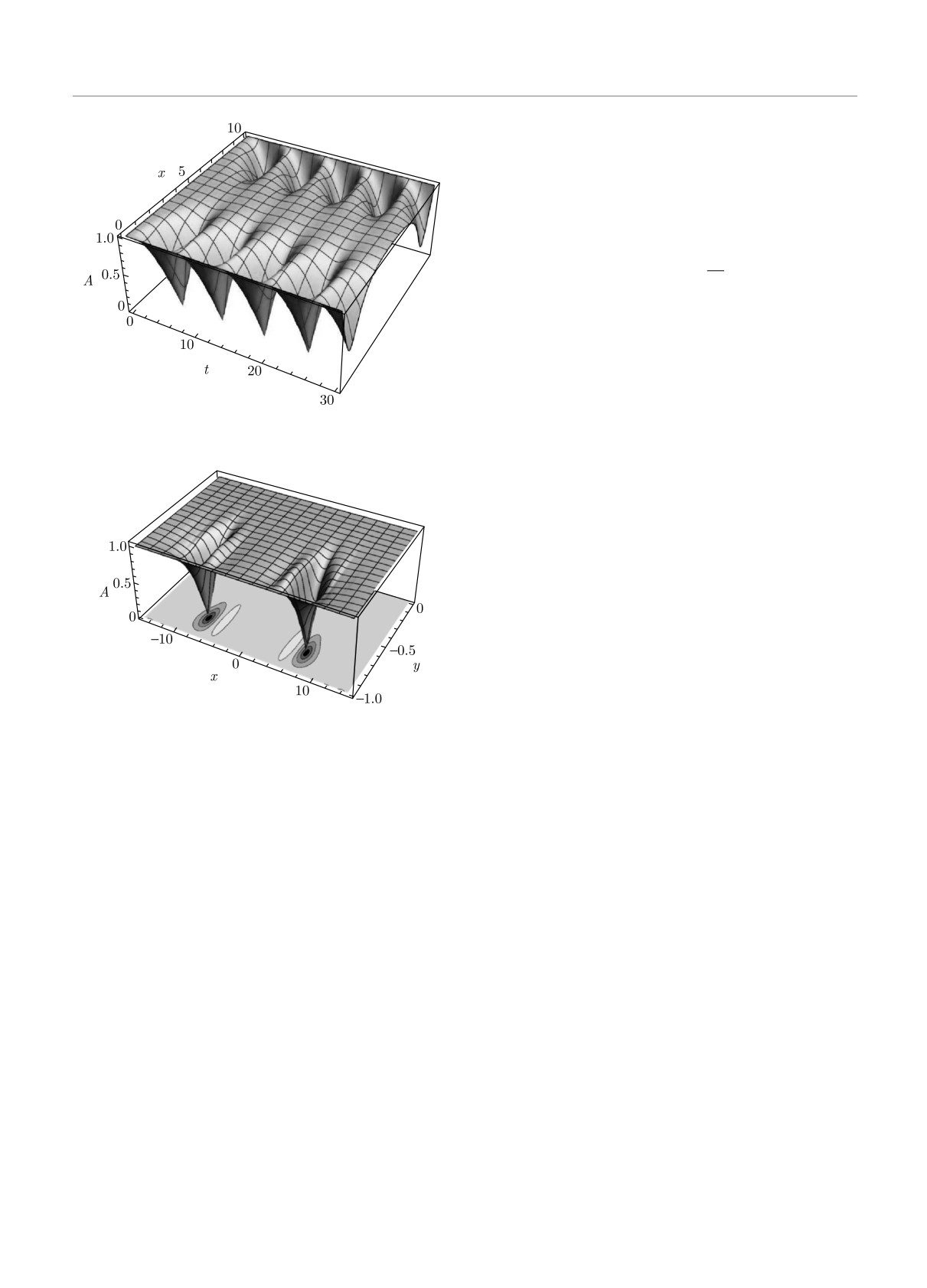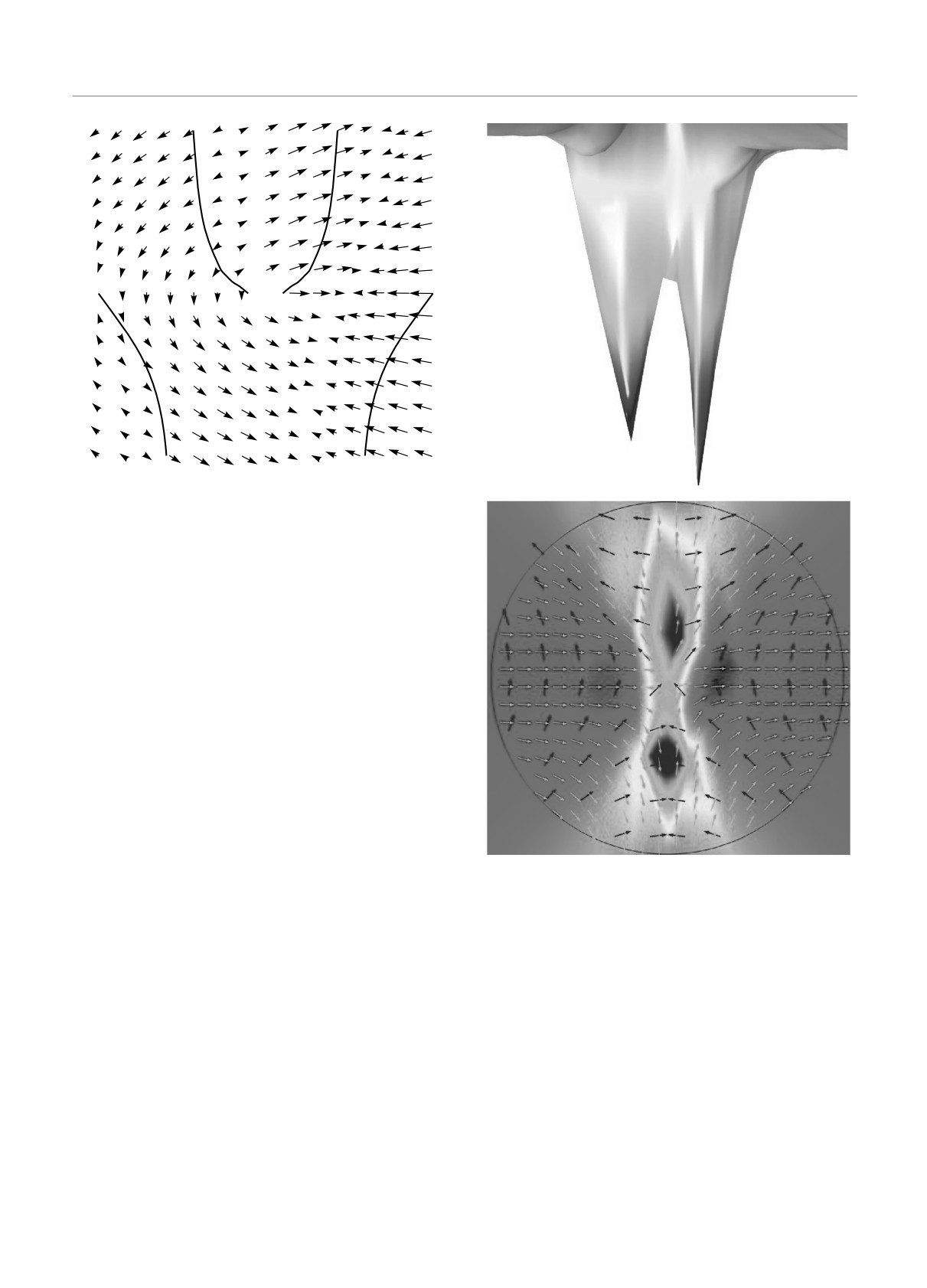ЖЭТФ, 2021, том 159, вып. 4, стр. 806-814
© 2021
PHASE SLIPS, DISLOCATIONS, HALF-INTEGER VORTICES,
TWO-FLUID HYDRODYNAMICS, AND THE CHIRAL ANOMALY
IN CHARGE AND SPIN DENSITY WAVES
S. Brazovskiia*, N. Kirovab
a Université Paris-Saclay, CNRS, Laboratoire de Physique Théorique et Modèles Statistiques
91405, Orsay, France
b Université Paris-Saclay, CNRS, Laboratoire de Physique des Solides
91405, Orsay, France
Received January 18, 2021,
revised version January 18, 2021
Accepted for publication January 18, 2021
Contribution for the JETP special issue in honor of I. E. Dzyaloshinskii’s 90th birthday
DOI: 10.31857/S0044451021040234
contrarily the conventional TDGL type, the resulting
equations still allow for a numerical modeling of tran-
sient processes related to space- and spatiotemporal
Abstract. This brief review recalls some chapters
vorticity in density waves (DWs).
in theory of density waves in quasi-1D electronic sys-
tems which may have appeared after inspirations from
1. Introduction.
studies of I. E. Dzyaloshinskii and collaborations with
1.1. Inspirations from I. E. Dzyaloshinskii.
him. First we address the spin density waves which
The authors had a chance to publish together with
rich order parameter allows for an unusual object of a
I. E. Dzyaloshinskii (I. E. D. in the following) the article
complex topological nature: a half-integer dislocation
[1] on doubly-quasi-periodic solitonic lattices emerging
combined with a semi-vortex of the staggered magneti-
in a 1D electronic system under simultaneous effects of
zation. It becomes energetically preferable with respect
the charge doping away from the half band filling and
to an ordinary dislocation due to the high Coulomb
of the spin polarization. This publication was in the
energy at low concentration of carriers. Generation of
course of our studies in theory of charge DWs (CDWs)
these objects should form a sequence of π-phase slips in
which had been started in 1976 by one of us (S. B., a
accordance with experimental doubling of phase-slips
thankful disciple of I. E. D.) under the inspiration and
rate. Next, we revise the commonly employed time-de-
initially with participation [2,3] of I. E. D. The trick of
pendent Ginzburg-Landau (TDGL) approach which is
the chiral transformations having been emploied in [2]
shown to suffer from a violation of the charge conser-
(see below), actually suggested by I. E. D., provided a
vation law resulting in nonphysical generation of parti-
handy frame to study adiabatic models of CDWs which
cles which is particularly pronounced for electronic vor-
later would lead S. B. to notice an instability of nor-
tices in the course of their nucleation or motion. The
mal electrons or holes, excited or injected to a CDW,
suggested consistent theory exploits the chiral transfor-
towards formation of solitons with the electron buried
mations taking into account the principle contribution
at the solitons’ midgap state, see [4] for a review. The
of the fermionic chiral anomaly to the effective action.
resulting physics of microscopic solitons and their ar-
The derived equations clarify partitions of charges, cur-
rays [5] can be traced back to I. E. D. invention of the
rents and rigidity among subsystems of the condensate
commensurability locking (published neglectfully only
and normal carriers and the gluing electric field. Be-
in conference proceedings [6]) and forth to his work
ing non-analitical with respect to the order parameter,
on exact solutions of many-body lattice models [7-10].
Much later, an indirect inspiration came to us [11, 12]
* E-mail: serguei.brazovski@universite-paris-saclay.fr
from the article [13], where I. E. D. had noticed that
806
ЖЭТФ, том 159, вып. 4, 2021
Phase slips, dislocations, half-integer vortices.. .
a presence of a dislocation in a crystal possessing the
should proceed via propulsion of these combined ob-
antiferromagnetic spin order enforces a curious half-in-
jects which provides a natural interpretation for a con-
teger vortex of spins’ rotations.
fusing 2-fold enhancement of a frequency generated by
In this short review, we shall firstly describe com-
moving SDWs in comparison with CDWs.
bined topological defects — half-integer vortices of dis-
Beyond transient dislocations contributing to phase
placements and spin rotations in incommensurate spin
slips, static arrays of dislocations can appear in lat-
DWs (SDWs) which might necessarily appear under ap-
eral geometries when the electric field is applied trans-
plications of the driving electric field. These consider-
versely to the direction x of the CDW sliding. Indeed,
ations are related to I. E. D. study [13] and are co-
the interaction energy eΦ∂xϕ/π of the deformed CDW
herent with a persistent interest in fractional vortices:
with the electric potential Φ resembles the one for a su-
from helium A ([14, 15] about the same time as [13])
perconductor under a magnetic field described by the
and triplet superconductors (reviews [16,17]) to FFLO
vector potential with the component Ax ≡ Φ. Then
phase [18, 19] and Bose condensate of polaritons [20]
the transverse to the chains electric field Ey = -∂yΦ
(see also Ref. [21] for a more recent review). This di-
acts upon the CDW phase analogously to the action
rection in general is in line with long standing interests
of the transverse magnetic field in a superconducting
of I. E. D. in topological defects, recall [22] and partic-
film. Hence, an array of static dislocations should ap-
ularly [23].
pear above the electric field threshold as the vortex
lattice above the critical field Hc1 in a superconductor.
Next, we shall quote and augment for modelling
Figures 1 and 2 illustrate the sequences of phase
quite a recent development [24] on construction of the
slips and the static dislocations. The plots were ob-
chirally invariant (recall [2]) description of transient
tained from numerical modelling of a TDGL type equa-
processes in a CDW or SDW in presence of normal
tions as it has been described elsewere [24, 36, 37].
carriers. This formulation is free from a drawback of
the non-conservation of condensed particles which we
2. Combined half-integer dislocation and the
show to be inherent to the traditional TDGL approach.
magnetization vortex in a spin density wave.
CDW and SDW are characterized by scalar and vec-
1.2. Significance of static and transient topo-
tor order parameters: ηcdw(R) = A exp(iϕ) and ηsdw =
logical configurations in incommensurate sliding
= Am exp(iϕ), where m is the unit vector of the stag-
density waves. The DWs, see reviews [25-28], are
gered magnetization and R = (x, r⊥) with x being the
seen as superstructures, usually weak (with an ampli-
chain direction.
tude A ≪ 1) and hence harmonic (A cos[q0 ·r+ϕ(r)], q0
The energy density of spin rotations m(R) in SDWs
and ϕ are the superstructure wave vector and phase).
is not affected by Coulomb forces:
The DWs are produced by modulations of electronic
charges and atomic displacements or of electronic spins
[
1
for CDWs or SDWs, correspondingly. The spectacular
Wspin{m} =
C∥ (∂xm)2 +
2NF
phenomena is the collective Fröhlich conductivity due
]
(
)
to the overall sliding with the collective current pro-
+
C⊥
(∂ym)2 + (∂zm)2
+Wsa .
(1)
portional to the phase velocity, jc ∝ ∂tϕ. The DW
sliding is ultimately related to the current conversion
Here NF = 2/πℏvF and vF are the density of states
process which necessarily involves topological defects
and the Fermi velocity of the parent metal,
C∥ and
[29] like solitons, dislocation lines/loops, and the tran-
C⊥ are the elastic moduli related to the rotation of
sient processes of phase slips which develop as the edge
the staggered magnetization unit vector m, and Wsa
dislocation line (D-line) proliferating/expanding across
is the spin anisotropy energy. Elastic moduli
C∥ and
the sample [30,31] or as the plane of the DW amplitude
C⊥ are similar to bare moduli of phase displacements
vanishing across a narrow sample [32-35].
taken without Coulomb interactions, i. e., C0∥ and C⊥
The DW deformations generate a local charge den-
in Eq. (2) below.
sity nc ∝ ∂xϕ which brings about a high cost of the
The energy for deformations related to phase dis-
Coulomb energy. The Coulomb enhancement of the
placements in both CDW and SDW takes a form
dislocation energy plays an intriguing role in SDWs
[
]
(
)2
(
)2
bringing to life a kind of a mixed topological object:
1
1
1
Wchrg{ϕ} =
C0
∂xϕ
+C⊥
∇⊥ϕ
+
a half-integer dislocation combined with a semi-vortex
2NF
∥ π
π
of a staggered magnetization vector. The phase slips,
+WC +Wstr,
(2)
necessary for the current conversion or the depinning,
807
S. Brazovskii, N. Kirova
ЖЭТФ, том 159, вып. 4, 2021
actions and the screening results in hardening of the
effective compessibility [38] which vanishes at Tc and
diverges at low T with freezing out of normal carriers.
The effective compressibility C∥ hardens with growing
r⊥ (starting from C0∥ at shortest interchain distances)
as C∥ ∼ r2⊥/r20 beyond the screening length of the par-
ent metal, r⊥ > r0 ∼ 1 Å, until it saturates beyond
√
ρn at the value which
the screening length rscr = r0/
grows activationally with lowering T. At r⊥ > rscr
C0∥ ⇒ C∥ = ρc/ρn,
C∥ ∝ ρc ∝ A2 ∝ (Tc - T) at T → Tc
and
C∥ ∝ ρ-1n ∝ exp(Δ/T) at T → 0.
Fig. 1. A time-periodic sequence of phase-slip events seen as
The resulting big energy of dislocations at small
a set of nodes of the DW amplitude A(x, t)
ρn does not prevent their creation which just requires
for bigger applied potentials, but the Coulomb energy
changes drastically the energy dependence of the dis-
location on its position Y (with respect to a coun-
terpart or a surface). While the spin-vortex energy
per its unit length is a standard WV ∼ Tc ln(Y/a⊥),
for the dislocation as the charged phase vortex, this
form of the energy is reached only when the Coulomb
interaction is screened at Y
≫ rscr, where WD ∼
∼ Tc(rscr/r0)ln(Y/rscr) with the energy scale being
greatly enhanced as rscr/r0.
Coulomb interactions become even more important
in an intermediate (wide at low T ) region r0 < r⊥ <
< rscr governed by the nonlocal, due to unscreened
Fig. 2. A static array of dislocations appearing in the electric
Coulomb interactions, elasticity with C∥ ∼ r2⊥/r20. For
field applied transversely to the direction x of DW displace-
dislocations with rscr ≫ Y ≫ r0, a curious confine-
ments
ment law is established with WD ∼ TcY/r0 meaning a
constant force acting upon the D-line.
(Y ) are similar only
The energies WV (Y ) and WD
where dimensionless parameters C0∥ and C⊥ are the
near Tc at small A (hence, at the vanishing gap Δ)
normalized compression and share moduli; C⊥
∝
when the abundant free carriers screen Coulomb in-
∝ (ATcNF a⊥)2 is a measure of the interchain cou-
teractions already at shortest distances. Otherwise, at
pling related to the transition temperature Tc (a⊥ is
the developed gap Δ > T, the energy of dislocations is
the interchain distance); Wstr is the stress energy from
greatly enhanced with respect to that of vortices which
an applied electric potential and/or from disbalance of
brings about the option of their splitting into combined
normal carriers which promote deformation and/or the
half-integer vortices. In SDWs, the Coulomb enhance-
motion of the DW.
ment of the dislocation energy plays a principal role
The Coulomb part of the energy, WC , comes from
bringing to life a special combined topological object:
the local charge density related to the DW displace-
the half-integer dislocation ϕ → ϕ + π accompanied
ments: nc = eρc∂xϕ/πa2⊥, where ρc and ρn = 1 - ρc
by the 180◦ rotation Oπ of the staggered magnetiza-
are the normalized densities of the condensate and of
tion m → -m. Indeed, the SDW order parameter
the normal carriers. The Coulomb interactions dras-
η = mcos(Qx+ϕ) allows for the following three types
tically affect the charged phase deformations of dislo-
of self-mapping η → η associated with vorticities νϕ
cations greatly increasing their energy and stretching
and νm.
the shape in the chains’ x-direction, as we shall remind
(i) Normal dislocation D2π: ϕ → ϕ + 2π ≡ ϕ and
below. Vaguely, the combined effect of Coulomb inter-
m → m; νϕ = 1 and νm = 0.
808
ЖЭТФ, том 159, вып. 4, 2021
Phase slips, dislocations, half-integer vortices.. .
Fig. 3. Vector-field m for the half-integer dislocation combined
with the semi-vortex of the magnetization. Solid lines indicate
constant DW phases. Due to the presence of the half-integer
dislocation, the number of sites changes between the upper
and the lower rows from 2.5 periods (6 + 6 + 3) to 2 periods
(7 + 5)
(ii) Normal m-vortex V2π : m → O2πm ≡ m and
ϕ → ϕ; νϕ = 0 and νm = 1.
(iii) Combined object DπVπ: ϕ → ϕ ± π and
m → Oπm = -m; νϕ = ±1/2 and νm = ±1/2.
In the last case, both the orientational factor m and
the translational one cos(Qx + ϕ) change the sign, but
their product in η stays invariant, as it is demonstrated
schematically in Fig. 3. Remind that at a given posi-
tion, the energies of vortices depend on their winding
numbers proportional to ν2ϕ,m
We must compare the energies of objects (i) and (iii)
under the requirement of the charge conservation, i. e.,
Fig. 4. Results of the modeling of the evolution from a sin-
preserving the total phase vorticity
∑νϕ. For magnetic
gle integer dislocation to the split pair of half-integer com-
vortices the total vorticity
∑νm does not need to be
bined vortices: (upper panel) the order parameter amplitude
conserved but in the bulk it must be kept zero; other-
A(x, y); (lowere panel) vector fields of the CDW phase and of
the spin rotation on the background of the density plot for the
wise, the energy of noncompensated vortices diverges
amplitude
logarithmically at large distances. For phase disloca-
tions, the energy divergence is not a limitation since it
is compensated by driving potentials. Hence, the only
as expected at low T, the magnetic vortex energy can
decomposition path for the conventional dislocation of
be neglected, then the decomposition gains nearly half
of the energy, (ν2π = 1)2 ⇒ 2(νπ = 1/2)2 = 1/2, which
the case (i) to the two pairs of half-vortices of the case
(iii) is D2π ⇒ {Dπ, Vπ} + {Dπ, V-π}. If the energy pa-
makes it inevitable.
Figure 4 demonstrates results of our modeling of the
rameters for both D and V were the same, then the dis-
sociation cost is zero: ν22π = 1 ⇒ 4ν2π = 1, and the re-
evolution from a single phase-only integer vortex (the
dislocation) to the split pair of half-integer combined
sult will depend on a tiny balance of similar coefficients.
But with dominating Coulomb energy of dislocations,
vortices.
809
S. Brazovskii, N. Kirova
ЖЭТФ, том 159, вып. 4, 2021
The known SDW crystals possess low symmetries
the explicitly gauge-invariant theory of superconduc-
which originates the spin anisotropy in all three direc-
tors [39, 40], this approach fails for DWs and other
tions. Being small, the anisotropy will not affect the
electronic crystals. Working at all steps explicitly with
arrangement in a vicinity of the D-line, but at large
interfering order parameter and normal electrons, em-
distances from the D-line, the π-rotation of spins will
ploying the chiral invariance, and taking the account
be concentrated in space within the Neél domain wall,
for the related quantum anomaly have allowed us [24]
as it has been outlined already in [13]. The wall will
to construct the treatable theory without descending
form a string (a plane in 3D) which tempts to confine
to the burdens of microscopic calculations.
the two combined objects.
The equations of motion for the CDW phase cer-
Unusually, there will be no confinement within a
tify the local equilibrium of forces (elastic, Coulomb,
quite wide region r⊥ < rscr, where the linear law,
frictional) with no relation to the charge conservation.
rather than conventional logarithmic one, for the D-line
Instead, the last is usually preserved automatically by
energy takes place as we have sketched above. Here,
construction of the charge and the current densities:
the total energy gain with respect to the normal D-li-
1
1
nc =
ρc∂xϕ, jc = -
ρc∂tϕ
(3)
ne is -EC N/2, where EC ∼ Tca⊥/r0 and N = Y/a⊥
π
π
is the number of chains separating combined vortices.
(to be compared with jsc ∝ ρsc∂xϑ for the current de-
This repulsive anti-confinement energy directly over-
pendence on the phase ϑ in superconductors).
runs the energy lost due to domain wall formation
The normalized (to T = 0) condensate density or
WAspin = wAN, both having the similar N-dependence.
the phase rigidity ρc(A) has a property that ρc(0) = 1
Usually wA ∼ 1 K/chain ≪ EC ∼ 101 K, so the net
and ρc(A) ∼ A2 → 0 at A → 0. The expressions
interaction between the two semivortices is strongly re-
(3) can ensure the charge conservation automatically
pulsive.
indeed, but only if the CDW amplitude is invariable:
Beyond the screening length r⊥
> rscr, the
A(t, x) = const, otherwise
Coulomb energy slows down while the WAspin keeps
growing linearly, then the total energy gain of two ob-
dnc
1
= ∂tnc+∂xjc =
(∂xρc∂tϕ-∂tρc∂xϕ) = 0.
(4)
jects with respect to one D-line is
dt
π
rscr
Tc
The charge conservation dnc/dt = 0 is violated in the
W = -E0 lnN+wAN, E0 ∼ Tc
=
√
r0
ρn
current-carrying state (∂tϕ = 0) if ρc is not space ho-
mogeneous (∂xρc = 0) and in the strained (charged)
Hence there is an equilibrium distance between the
state ∂xϕ = 0 if ρc varies in time, ∂tρc = 0. It is ulti-
semi-vortices, Neq
∼ E0/wA ∝ 1/√ρn, which di-
mately necessary to take into account the normal car-
verges with freezing out of the screening when ρn → 0.
riers explicitly, without integrating them out prema-
Already at accessibly low temperatures, the string
turely. At first sight, that would require for descend-
length may reach the sample width which is typically
ing to the fully microscopic theory with its notorious
about 1 μm.
complications even in linear or gapless regimes [33,41].
3. Two-fluid hydrodynamics for collective
Still, there is a way [24] to keep the phenomenology
and normal variables in density waves.
which is based on the knowledge of chiral invariance
Related cases of vortices in superconductors and
and transformation, importantly taking into account
dislocations in DWs
[32-34] are described usually
the chiral anomaly.
within GL-like models and their time-dependent
The Lagrangian H - iℏ∂t for electrons in 1D CDW
(TDGL) generalizations. While being consistent for
has a form
(
)
iϕ
-iℏ∂t - iℏvF ∂x + Φ - vF Ax
Δe
L=
,
(5)
Δe-iϕ
-iℏ∂t + iℏvF ∂x + Φ + vF Ax
where Φ and Ax are the scalar and the vector poten-
ℏvF
Φ -→ V = Φ +
∂xϕ,
tials. The chiral transformation ψ± -→ ψ±exp(±iϕ/2)
2
[2] brings the wave function Ψ to the local frame of a
(6)
distorted CDW phase. It eliminates the phase factors
in non-diagonal elements in L, but in expense of addi-
ℏ
Ax -→ A∗x = Ax +
∂tϕ,
tional parts in Φ and Ax:
2vF
810
ЖЭТФ, том 159, вып. 4, 2021
Phase slips, dislocations, half-integer vortices.. .
Ex -→ E∗x = -∂xV + ∂tA∗x =
a) The term with ϵΔ in Eq. (9) yields to (8) the
(
)
ℏvF
1
forth order gradients of the phase (∂2xxϕ)2 instead of
=Ex -
∂2x -
∂2t
ϕ.
(7)
2
v2
the expected second order (∂xϕ)2.
F
b) The singularity in k in the term with ρn seems
The additions to Φ and Ax from x- and t-derivatives
at first to serve fortunately by canceling excess gradi-
of the phase are naturally interpreted as the Fermi en-
ents leading to the contribution proportional to (∂xϕ)2:
ergy shift δEF = vF δPF following the Fermi momen-
δWρn = -ρn(ℏvF /4π)(∂xϕ + πNF Φ)2. This expres-
tum shift δPF = ℏ∂xϕ/2 under the CDW phase defor-
sion brings two confusions with respect to the expected
mations. Under the CDW phase deformation and the
Wρc = ρc(ℏvF /4π)(∂xϕ)2. The signs in expressions
applied electric field Ex, the electrons experience the
for Wρn and Wρc are opposite, and also temperature
chiral invariant potentials V and A∗x and the longitudi-
dependencies are conflicting among coefficients ρn (ex-
nal force E∗x.
pected to rise from zero at T = 0 up to 1 at Tc) and
At first sight, we have arrived at the transparent
ρc (expected to fall to zero at Tc starting from 1 at
picture of a 1D Dirac semiconductor with the gap 2Δ =
T = 0).
= 2AΔ0 under the effective electric field (7), and it
These contradictions can be traced back to the no-
looks straightforward to exclude the fermions to arrive
∫
tion of the chiral anomaly, and they can be cured by
at an effective action S{Φ, ϕ, A} =
W dx dt. And here
properly taking this anomaly into account. The chiral
we arrive at puzzling contradictions.
anomaly is ubiquitous in the premature linearization of
(i) In view of Eq. (7), the free energy W should
electronic spectra. First, in the course of the lineariza-
contain the potential and the phase only in the in-
tion, the control is lost of the position of the bottom
variant combination V . Having choosen the phase as
of the electronic band, hence of the difference between
(ℏvF /2)∂xϕ = -Φ, the effective potential V disappears
actions of the external potential Φ and of the Fermi
from the action, then no density and no polarization are
energy shifting δEF which wrongly appear to be ad-
perturbed with respect to Φ. This contradicts to ba-
ditive. Moreover, the whole energy cost of the chiral
sic properties of the CDW in both the semiconductor
transformation δWCT is lost. This energy can be cap-
with respect to electrons and the metal in the collective
tured from the non-linearized spectrum of the normal
behavior.
metal if we consider the chiral transformation pertur-
(ii) We definitely expect W to contain the term pro-
bation δnCT = ∂xϕ/π as a redistribution of the total
portional to ρc(∂xϕ)2, where ρc is a collective density
particle density accompanying this transformation:
responsible for the phase rigidity. But treating the La-
grangian (5) perturbatively with respect to the effective
ℏvF
electric field (7), we evidently should get
δWCT =
(∂xϕ)2 +Φ∂xϕ,
(10)
4π
π
ϵ(k, ω)
δWn = -
(E∗x)2 =
where the first term is the density perturbation cost
8πe2
(
)2
(δnCT )2/2NF and the second term is its potential en-
ϵ(k, ω)
ℏvF ∂2ϑ
=-
-
+Ex
,
(8)
ergy δncΦ. Beyond these physical arguments [43,44],
8πe2
2
∂x2
the derivation of the chiral anomaly in the spirit of
where ϵ is the dielectric susceptibility as a function of
the field-theory procedure of regularization of fermionic
the wave number k and the frequency ω (the last will
determinants was demonstrated for CDWs [45] and
be neglected here for shortness). At small k,
for SDWs [45, 46], recall also the special field-induced
SDWs [47].
1
1
ρn
dn
ϵ=ϵΔ +
,
=
,
ρn =
N-1F.
(9)
Bringing together the nonperturbative contribution
(lk)2
l2
r20
dζ
(10) and the perturbative one (8), we get
Here n is the concentration of free electrons related to
their chemical potential ζ and ρn is the normalized den-
Wtot = δWρn + δWCT =
sity of states which also will be found to be the normal
(
)
density. The dielectric constant ϵΔ ∝ (r0ξ0)-2 collects
ℏvF
Φ2
=ρc
(∂xϕ)2 +Φ∂xϕ
-ρn
,
(11)
the polarization of electrons gapped by the CDW while
4π
π
πℏvF
ρn comes from conducting carriers thermally excited or
injected [42] above the gap providing the finite screen-
where ρc = 1 - ρn. The above equation correctly mani-
ing length l = r0/√ρn. Both contributions to δWn
fests the expected dependencies in T and A yielding
bring drastic contradictions.
also the important relation ρc + ρn = 1.
811
S. Brazovskii, N. Kirova
ЖЭТФ, том 159, вып. 4, 2021
The total charge density becomes
Here γϕ = γA2, γ = const and γA = const are the
damping coefficients; γϕ is related to the sliding CDW
∂Wtot
1
conductivity σCDW as γϕσCDW = NF e2/a2⊥ = 1/4πr20.
ntot =
=
ρc∂xϕ - ρnΦNF =
∂Φ
π
In spite of a superficial similarity, Eqs. (14)-(16)
1
=
∂xϕ - ρnV NF .
(12)
show striking differences with respect to commonly
π
use TDGL ones. Thus, in Eq. (14) the conventional
The above illustrative discussion was valid in lowest
term κ⊥A(∇⊥ϕ)2 does not find its partner with the
bilinear approximation in gradients and potentials for
x-derivative of ϕ as if the longitudinal gradient of ϕ
the constant amplitude A. Below, we shall suggest a
does not suppress the amplitude — the phase-slip nodes
general nonlinear scheme necessary for modeling con-
would not appear then. In Eqs. (15) and (16), the terms
figurations with vortices.
containing ∂xϕ, ∂xxϕ, and (∂xϕ)2 are not multiplied
The above relations written for the limit A = const
by A2, so the attempt to present them as derivatives
and for small deviations of ne and nh can be generalized
of Ψ will bring singularities proportional to 1/A and
∫
by extending the energy functional as
W dx with
1/A2. Contrary to conventional GL-type equations,
now Eqs. (14)-(16) are nonanalytic in the order pa-
[
]
ℏvF
rameter η = Aexp(iϕ) or, in other words are singular
W =
κx(∂xA)2+κ⊥(∇⊥A)2+κ⊥A2(∇⊥
ϕ)2 +
4π
in its amplitude. Nevertheless, there are hidden cancel-
{
}
(
)
ℏvF
1
ℏvF
lations allowing to compensate for singularities, even if
+
(∂xϕ)2 +
Φ∂xϕ
+ Φ+
∂xϕ n +
4π
π
2
implicitly, which is vitally important for allowance of
space- and spaciotemporal vortices.
ϵhosta2⊥
+ F(A,ne,nh) -
(∇Φ)2,
(13)
There are some technical challenges in numerical
8π
implementations of the quoted above equations which
where ϵhost is the dielectric permittivity of the host
one commonly does not meet working within conven-
crystal.
tional GL approaches, see, e. g., Refs. [35,48]. The first
Here the parameter κ⊥ is the CDW share modu-
is the control of compensations at A → 0 in expres-
lus coming from the interchain coupling of CDWs, and
sions for total charges, currents, and the condensate
the on-chain rigidity κx ∼ 1 (to be put κx = 1);
energy bringing to action the hidden function of the
F (A, ne, nh) is a free energy as a function of the nor-
condensate density ρc. The second is the entanglement
malized gap value A = Δ/Δ0 and of the concentra-
in dependencies of thermodynamic functions and their
tion of normal carriers: electrons ne and holes nh with
derivatives on A and on n or ζ: approaching of n or ζ
n = ne - nh. The equilibrium value Aeq is connected
to critical values should eliminate the energy minimum
with ne and nh via the minimum of F (A, ne, nh) in such
over A at A = 0 opening the metallic state, e. g., in the
a way that Aeq(ne, nh) vanishes when ne,h or, better
vortex core.
say, their chemical potentials ±ζ surpass critical val-
The best, and may be the only analytically trans-
ues, hence the metallic phase with A = 0 is restored.
parent, advancing is possible with the simplest Landau
The terms in brackets {. . .} are originated by the chiral
type expression for F :
anomaly of Eq. (10) coming from background deforma-
[
]
tions of the CDW phase, the next term (proportional
(
)2
n2
1
n
to n) comes from the energy of intrinsic electrons in the
F (n, A) =
+
-τ +
×
2NF
2
ncr
combined potential V .
b
Assuming the dissipative regime for both ϕ and A,
× (AΔ0)2NF +
A4Δ20NF ,
(17)
functional derivatives of (13) yield equations for the
4
time evolution and the Poisson equation for Φ:
where a, b ∼ 1. In Eq. (17), the first term is the con-
∂F
tribution of the normal metal, while two other terms
∂2xA + κ⊥∇2⊥A + κ⊥A(∇⊥ϕ)2 -
= γA∂tA,
(14)
give the Landau type expansion in the order parame-
∂A
ter with the proximity τ ∝ (1 - T/Tc) to the transition
temperature being shifted by presence of the normal
∂2xϕ + πNF ∂xΦ + π∂xn +
carriers which critical concentration is ncr.
(
)
+κ⊥∇⊥
A2∇⊥ϕ
=γϕ∂t,
(15)
We have performed the numerical modeling employ-
ing the following combination of equations: Eq. (13)
for A with F given by Eq. (17), Eq. (14) for ϕ, and
1
∂xϕ + n = -NF r20∇2Φ.
(16)
the dissipative equation for m generated by the func-
π
812
ЖЭТФ, том 159, вып. 4, 2021
Phase slips, dislocations, half-integer vortices.. .
tional (1). The vortices can be spontaneously generated
4.
S. Brazovskii and N. Kirova, Soviet Science Revies,
only if equations are written in invariarian variables,
ed. by I. M. Khalatnikov, Harwood Acad. Publ., New
rather than in the economical form for non-unique
York (1984), Vol. A5, p. 99.
phase ϕ and the angle θ. The order parameter ηSDW =
5.
S. Brazovskii, AIP Conf. Proc. 1134, 74 (2009).
= Am exp(iϕ) is written as ηSDW = (u + iv){p, q}.
For the CDW or for frozen alligned spins in SDW,
6.
I. Dzyaloshinskii, Nobel Symposium 24, 143 (1973).
the invariant variables are just u and v. For a SDW
7.
S. A. Brazovskii, I. E. Dzyaloshinskii, and I. M. Kri-
with a spin vorticity, the allowed varibles were taken
chever, Sov. Phys. JETP 56, 212 (1982).
as a set of four bilinear combinations {α, β, γ, δ} =
= {up, uq, vp, vq} imposing the apparent constraint
8.
S. A. Brazovskii, I. E. Dzyaloshinskii, and I. M. Kri-
αδ = βγ. Examples of resulting calculations are shown
chever, Phys. Lett. A 91, 40 (1982).
in Figs. 1, 2, and 4.
9.
I. E. Dzyaloshinskii and I. M. Krichever, Sov. Phys.
4. Conclusions.
JETP 56, 908 (1982).
A necessity of semi-vortices in conventional antifer-
10.
I. E. Dzyaloshinskii and I. M. Krichever, Sov. Phys.
romagnets in presence of frozen-in host lattice dislo-
JETP 58, 1031 (1983).
cations was understood already by I. E. D. [13]. In
the SDW, the semi-vortices become the objects of the
11.
N. Kirova and S. Brazovskii, J. de Phys. IV 9,
lowest energy created in the course of phase slip pro-
Pr10-119 (1999).
cess; the normal dislocation must split into two objects
12.
N. Kirova and S. Brazovskii, J. de Phys. IV 10,
of the combined topology with the repulsion between
Pr3-183 (2000).
them. The combined topological objects, where the
spin rotations are coupled to DW displacements, are
13.
I. E. Dzyaloshinskii, JETP Lett. 25, 98 (1977).
stabilized by lowering the Coulomb energy of disloca-
14.
G. E. Volovik and V. P. Mineev, JETP Lett. 24, 561
tions. This combination effectively reduces the SDW
(1976).
period.
Exploiting the chiral transformation and under-
15.
M. C. Cross and W. F. Brinkman, J. Low Temp.
Phys. 27, 683 (1977).
standing the role of the chiral anomaly allows formu-
lating a phenomenological theory in terms of equations
16.
I. A. Lukyanchuk and M. E. Zhitomirsky, Supercond.
for the DW complex order parameter, the electric po-
Rev. 1, 207 (1995).
tential, and the concentration of normal carriers. This
approach resolves the problem of violation of the con-
17.
G. E. Volovik, PNAS 97, 2431 (2000).
servation law for condensed carriers rising dangerously
18.
L. Radzihovsky and A. Vishwanath, Phys. Rev. Lett.
for nonstationary inhomogeneous regimes; that allows
103, 010404 (2009).
to model consistently such strongly nonlinear effects as
phase slips and nucleation and propagation of phase
19.
S. Brazovskii, Physica B 404, 482 (2009).
vortices.
20.
Y. G. Rubo, Phys. Rev. Lett. 99, 106401 (2007).
The full text of this paper is published in the English
21.
V. P. Mineev, Low Temperature Physics/Fizika Niz-
version of JETP.
kikh Temperatur 39, 1056 (2013).
22.
S. I. Anisimov and I. E. Dzyaloshinskii, Sov. Phys.
JETP 31, 773 (1970).
REFERENCES
23.
I. E. Dzyaloshinskii and G. E. Volovik, Ann. Phys.
125, 67 (1980).
1. S. Brazovskii, I. Dzyaloshinskii, and N. Kirova, Sov.
Phys. JETP 54, 1209 (1981).
24.
S. Brazovskii and N. Kirova, Ann. Phys. 403, 184
(2019).
2. S. Brazovskii and I. Dzyaloshinskii, Sov. Phys. JETP
25.
P. Monceau, Adv. Phys. 61, 325 (2012).
44, 1233 (1976).
26.
G. Grüner, Rev. Mod. Phys. 60, 1129 (1988).
3. S. Brazovskii, I. Dzyaloshinskii, and S. P. Obukhov,
Sov. Phys. JETP 45, 814 (1977).
27.
G. Grüner, Rev. Mod. Phys. 66, 1 (1994).
813
S. Brazovskii, N. Kirova
ЖЭТФ, том 159, вып. 4, 2021
28. Charge Density Waves in Solids, ed. by L. Gor’kov
39. B. I. Ivlev and N. B. Kopnin, Adv. Phys. 33, 47
and G. Grüner, Elsevier Sci. Publ., Amsterdam
(1984).
(1990).
40. N. Kopnin, Theory of Nonequilibrium Superconduc-
29. S. Brazovskii and N. Kirova, JETP 129, 659 (2019).
tivity, Oxford Univ. Press, U.K. (2001).
30. N. P. Ong, G. Varma, and K. Maki, Phys. Rev. Lett.
41. S. Artemenko and A. Volkov, see [28], p. 365.
52, 663 (1984).
42. . S. Brazovskii, N. Kirova, H. Requardt, F. Ya. Nad,
31. N. P. Ong and K. Maki, Phys. Rev. B 32, 6582 (1985).
P. Monceau, R. Currat, J. E. Lorenzo, G. Grbel, and
Ch. Vettier, Phys. Rev. B 61, 10640 (2000).
32. L. P. Gor’kov, JETP Lett. 38, 87 (1983).
43. S. Brazovskii, J. de Phys. I 3, 2417 (1993).
33. L. P. Gor’kov, see [28], p. 403.
44. S. Brazovskii, J. de Phys. IV 3, C2-267 (1993).
34. L. P. Gor’kov, Sov. Phys. JETP 59, 1057 (1984).
35. I. Batistic, A. Bjelis, and L. Gor’kov, J. de Phys. 45,
45. I. V. Krive, A. S. Rozhavsky, and V. A. Rubakov,
JETP Lett. 46, 121 (1987).
1049 (1984).
36. T. Yi, N. Kirova, and S. Brazovskii, Eur. Phys. J.,
46. K. Sengupta and N. Dupuis, Phys. Rev. B 61, 495
Special Topics 222, 1035 (2013).
(2000).
37. T. Yi, A. Rojo Bravo, N. Kirova, and S. Brazovskii,
47. V. M. Yakovenko and H.-S. Goan, Phys. Rev. B 58,
J. Supercond. Nov. Mag. 28, 1343 (2015).
10648 (1998).
38. S. N. Artemenko, A. F. Volkov, and A. N. Kruglov,
48. S. M. Gol’berg, N. B. Kopnin, and M. I. Tribel’skii,
Sov. Phys. JETP 64, 906 (1986).
Sov. Phys. JETP 67, 812 (1988).
814








